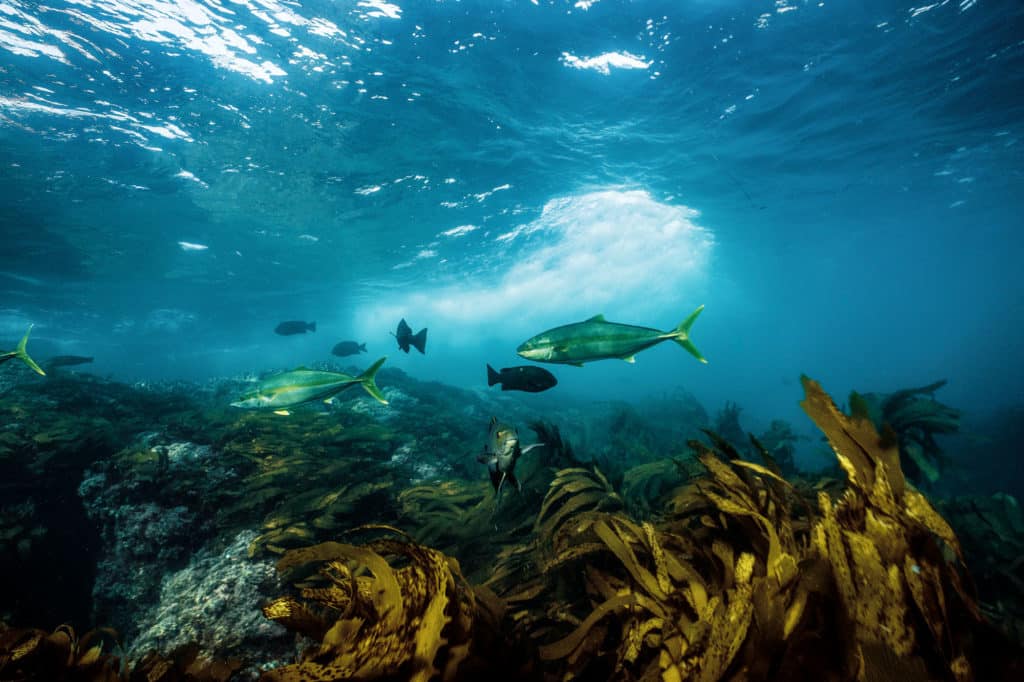
The number of seagulls in the area made it obvious that another influx of pelagic red crabs had swarmed into the lee of Catalina Island during the previous night’s full moon. Over the past few warm-water years, each wave of these crabs had brought with them biting tuna and yellowtail. But this was early March, and the days of warm water were a distant memory. So I bypassed the birds, continuing toward my intended target: the calico bass that live in the island’s rocky shallows.
The bass were biting the swimbaits that I cast toward shore. But I kept an eye on the seagulls outside us, which were doing their familiar hopscotch routine as they fed almost passively on crabs. For just a moment, the pattern of flutter up, land, eat a crab, sit for a minute, then repeat was replaced by a flare of several birds that circled intently before going back to picking away at the crabs. “Did you see that?” I asked my fishing partner, Matt Kotch, who answered in the affirmative.
With hopes high but expectations low—it being March, after all—we stowed our bass tackle and headed to where we had just seen the commotion. As we approached, the birds grew active again, and below them a school of California yellowtail came to the surface to feed on a ball of crabs they had corralled.
Pulling the boat out of gear, I grabbed my jig stick and let fly a Tady 45 Surface Iron just beyond the school and ahead of its direction of travel. Kotch, quicker on the draw, was already cranking his lure across the surface with six or seven big yellows in hot pursuit.
That chase lasted only a second before the lead fish inhaled his jig, then turned and ran for deep water. I had my own reel in gear and handle in motion as soon as my jig hit the water, and got only a couple of turns before coming tight and then watching line melt off the reel’s spool as it spun quickly in the opposite direction.
I had lost track of where the remainder of the school had gone by the time we’d boated our fish. In fact, there was no sign they’d ever been there at all. The seagulls, which had returned to unhurriedly feeding on the crabs, formed a line that stretched as far as I could see in both directions. This expanse of forage and the relatively small size of the school we’d seen put the chances of us finding another needle in that day’s haystack low enough that we racked our jig sticks and went back to bass fishing, glad to have had the opportunity we did.
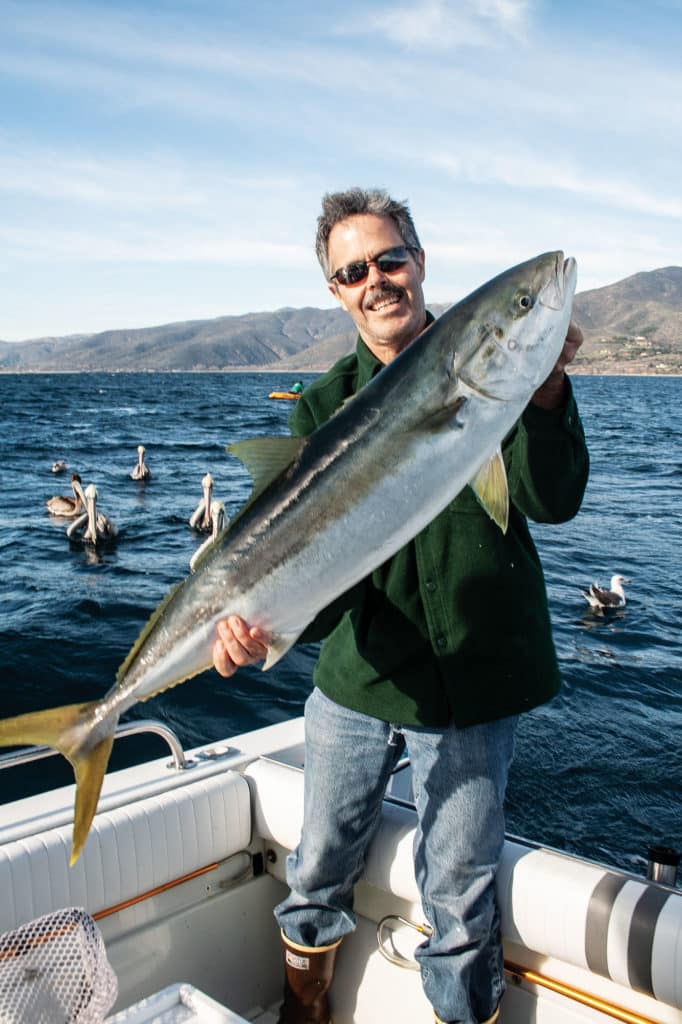
Identifying Opportunity
When it comes to targeting yellowtail in Southern California waters, the first step to success is the ability to identify opportunity when it presents itself. While we were lucky enough on that March day to see the birds acting fishy, yellowtail opportunity doesn’t always present itself that plainly.
To better understand the subtleties of what to look for, I turned to Capt. Duane Mellor (Pinnacle Sportfishing, Mission Bay, San Diego). His track record when it comes to taking advantage of yellowtail opportunities qualifies him as one of the best skippers in the business.
“Yellowtail behavior is very predictable,” Mellor says, explaining how he consistently catches fish on his trips to the Coronado Islands. “If there are fish at the islands, you’re going to find them associating with high spots, ridges or kelp beds, and if they’re feeding, they’re going to be on the up-current edge of whatever structure they’re around. So, if you’re looking for yellows at North Island, for example, you’ll want to start by looking at the part of the island that’s facing into the current.”
The next step once a boat is in the correct general area, according to Mellor, means figuring out just where the fish are feeding. “Once I find an area with good current and clean water, I’ll start looking for signs of yellowtail. In winter and early spring, the fish at the islands usually stay deep, moving up in the column as the water temps rise,” Mellor says. “With the warm water we’ve had the past couple of years, the fish have been biting on or near the surface through most of the year. So instead of driving around looking for deep schools of yellowtail, I’ll watch the birds and bait to tell me where the fish are. Everyone knows what bird schools look like, so that’s a no-brainer, but finding the right kind of bait marks on the meter is a little more involved.”
According to Mellor, “the right kind of bait marks” means bait that’s being preyed upon. “If the bait is suspended in the column, I’ll look for both tight and broken-up baitballs. If you’re driving around and metering loose schools of bait and suddenly run over some tight schools, you can be sure that there’s something chasing that bait around.”
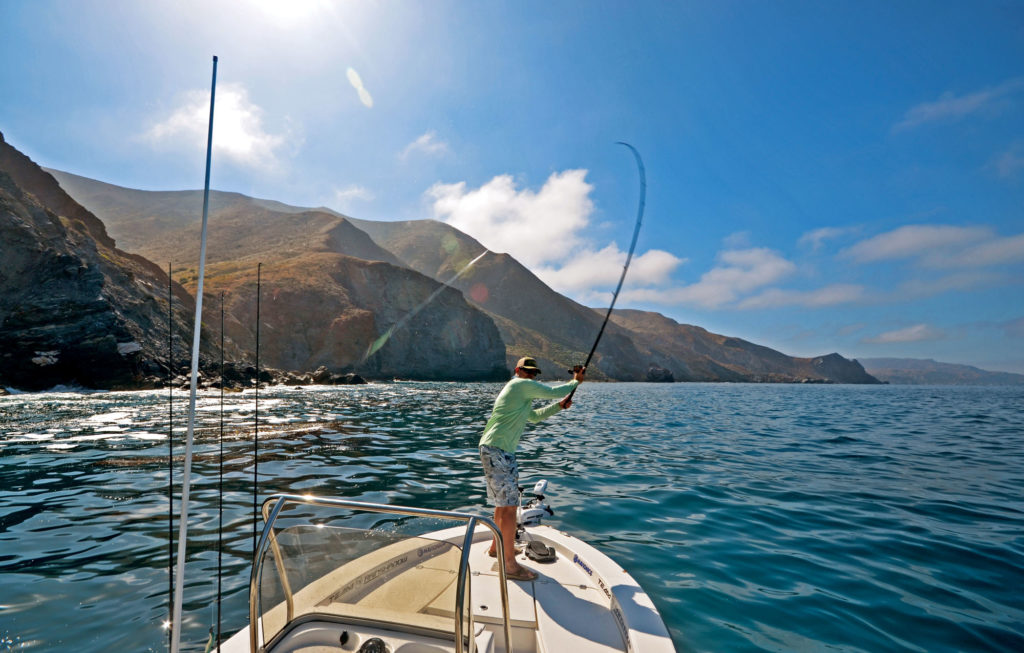
Gearing Up
Once you know what to look for, you need to have the right tackle for the different presentations you’ll be using to target yellowtail. Three techniques will cover all of your yellowtail-fishing bases, and each method needs a dedicated rod-and-reel combo: surface iron (light metal jigs), yo-yo iron (heavy metal jigs), and a combo to fish live bait.
Fishing surface iron for yellowtail is the most popular method of targeting them, and as a result, you can find lots of opinions regarding the “right” rod-and-reel combo to use. Since casting distance matters, most anglers choose a rod from 8 to 10 feet in length. Historically surface-iron rods have always been fiberglass, but more companies are making graphite and graphite-composite rods with the proper action to fish the iron. My current jig stick of choice is the Rainshadow RCJB106H, a 9-foot graphite-composite rod with a glass tip and a graphite butt section making for a heavy-action rod with a tip soft enough to load up when casting the jig.
As with rods, there are lots of favorite reels. Most yellowtail enthusiasts prefer star-drag reels due to the ease of clicking the reel in gear after casting. With more and more anglers fishing Spectra line, narrower reels like the Penn Fathom 25N have become popular. I fish mine brim full of 80-pound Spectra to a short 3-foot, 60-pound fluorocarbon leader. My go-to surface-iron lure is the Tady 45 in mint-and-white. This size and color will get bit any time yellowtail are feeding on the surface, even if they’re keyed in on red crabs.
The next combo you’ll need is one suited to fish the heavier yo-yo iron. There’s no casting involved when fishing the yo-yo, so you’ll want a shorter rod in order to put some of the leverage back in your favor. Most anglers choose an extra-heavy, action 7-foot rod when fishing the yo-yo; with the surface iron, graphite composite rods are popular. My yo-yo combo is a Rainshadow RCJB84XH matched with a Penn Fathom 40N two-speed reel filled with 100-pound Spectra and a short 80-pound fluorocarbon leader.
A fast retrieve is often the key to getting bit when fishing the yo-yo. The 40N’s tall (narrow) spool and a 5.5-to-1 gear ratio mean it retrieves 42 inches of line per crank; that cuts down on fatigue when fishing in deep water. Once hooked up, low gear makes for an easier fight, especially if the fish is coming out of 300 feet of water.
There are lots of great yo-yo jigs on the market, but my standard is the Tady 4/0 heavy in mint-and-white. If you haven’t noticed the trend, mint-and-white is pretty much all I fish because it always seems to work.
The final arrow in your quiver should be a live‑bait rod for slow-trolling. Mine is a Rainshadow RCLB80M, which is an 8-foot, medium-action graphite-composite rod with a light glass tip and a stout graphite butt. I match the rod with another Penn Fathom 25N, this one full of 65-pound Spectra, and I’ll adjust my leader and hook size to match the bait I’m fishing. This combo can fish anything from 25-pound fluorocarbon with a small sardine to 60-pound fluorocarbon when using mackerel as bait.
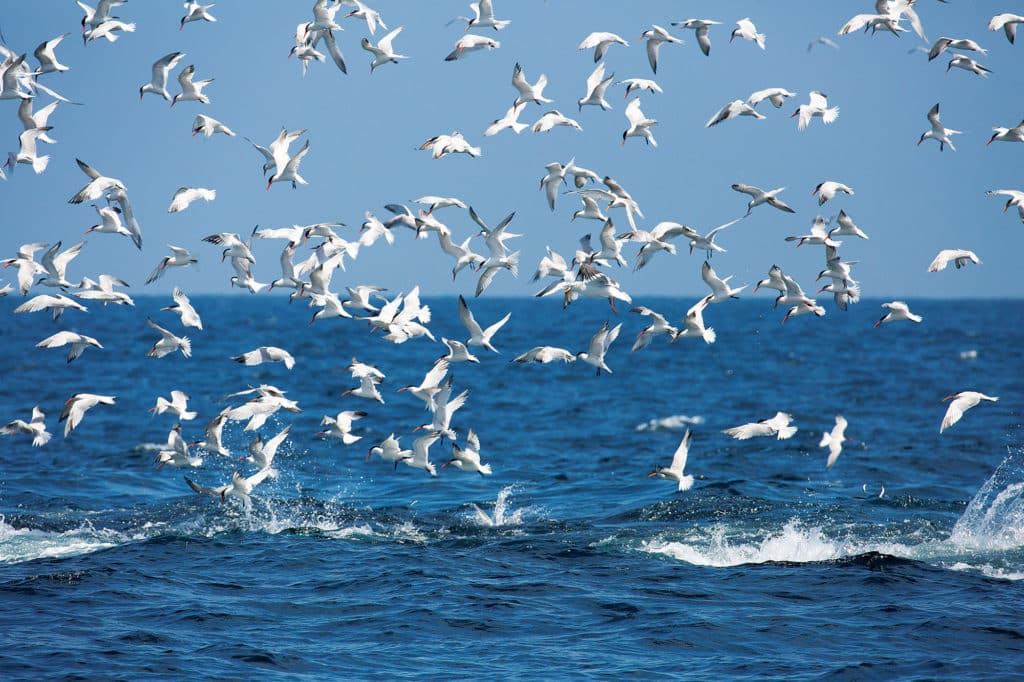
The Presentations
As Mellor explained, finding yellowtail is easy when they’re feeding on the surface, but finding them when they’re orienting around structure, like the reefs on the up-current end of North Island, takes a little more work. That’s where slow-trolling comes in. Once you locate an area with structure, current, forage, and good water color and temp, you can quickly find out if there are any feeding fish around by dragging a couple of sardines or mackerel through the area.
Trolling distance for yellowtail depends on water depth. If you’re trolling in 50 feet of water, you don’t want your bait much farther than that distance behind the boat because, once hooked, the yellowtail is going to head toward structure. If you’ve got too much line out, you’re going to get rocked before you even get on top of the fish. Regarding speed, I like to run my boat with the motor clicked just into gear—so about 1.5 to 2.5 miles per hour, depending on current.
When yellowtail are feeding on bait schools but not showing on the surface, fishing the yo-yo jig is the most effective way to target them. The presentation is as simple as the name implies: Drop the jig to whatever depth the fish or bait are marking, wind it back to the surface as fast as you’re able to turn the handle, and repeat. If the fish aren’t responding, try a fast stop-and-go retrieve; that sometimes tricks them into striking.
This technique will wear out the uninitiated pretty quickly, so if you’re new to it, you’re going to want to focus your efforts on high-percentage areas. As Mellor suggested, find the bait schools that look like they’re having a bad day, and you’ll likely find biting fish.
When targeting yellowtail feeding on the surface, there is no more valuable tool to use to find them than the common tern. These birds, more than any other, are the ones to watch when fishing for yellowtail. Find terns working a small area with an appearance of purpose, and you can be sure some sort of feeding activity is occurring below.
Invest some time studying tern behavior to get a good understanding of what these birds are telling you. Basically, terns are efficient hunters. If you see a group of them just cruising around and occasionally diving down to pick something off the water, they’re simply biding their time while waiting for something to happen. The higher the terns are flying, the deeper whatever they’re tracking is in the water column. So if those lazily high-flying terns suddenly fly low and more urgently, it’s time to get that jig in the air because the yellows are about to pop.
Read Next: Fishing the Bays of Southern California
Once you’ve located fish, terns also help you keep track of their direction of movement. When yellows feed at the surface, they usually attract seagulls, pelicans and cormorants, as well as terns. But when those fish start moving, the terns stay on the front edge of the assault. Remain off to the side of those birds while running well ahead of them, then shut down and wait for them to come within casting range before firing a jig.
Once you get hooked on running-and-gunning on yellows, you’ll be eyeing every gull or tern you see, even on a cold March morning, just hoping they’ll flare up and let you know some big yellows might lurk below.
The Road Less Traveled
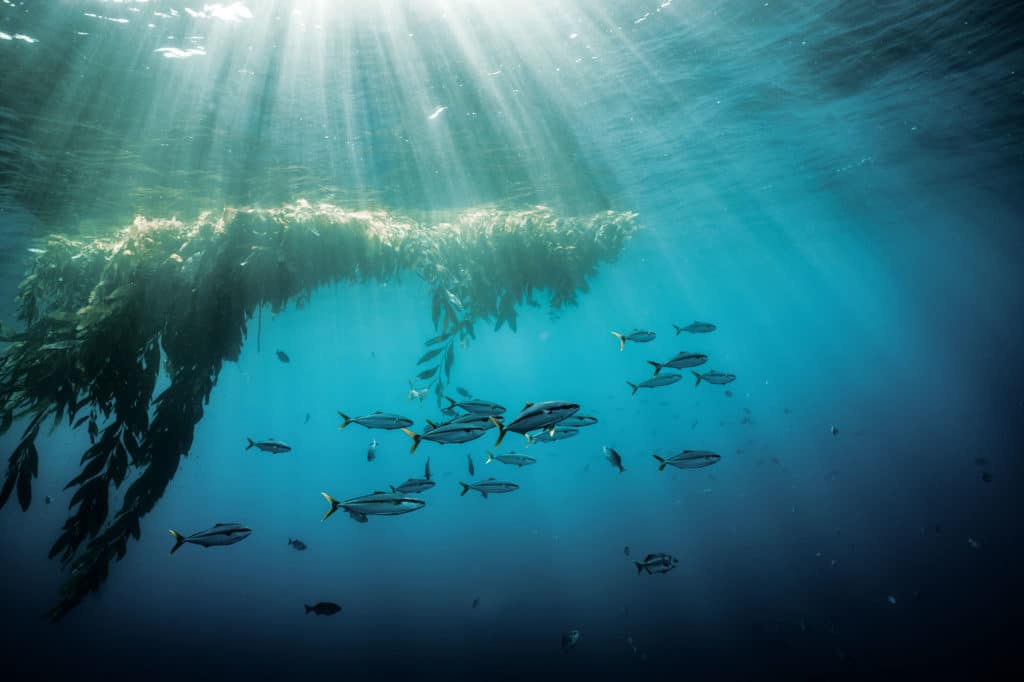
Just because everyone is there doesn’t mean it’s the place to be. Capt. Duane Mellor stresses: “People who aren’t familiar with fishing yellowtail have a tendency to want to fish around the fleet. I understand that it’s tempting to go to an area that’s probably biting, but all you’re going to do is get destroyed by seals and run over by guys who don’t know what they’re doing.”
If you find a parking lot of boats in the area you had planned to fish, you’re better off driving away from that mess and looking for similar but less-crowded conditions in another area. If there are good conditions and biting fish at one spot, chances are you’ll find those conditions and biting fish at another spot nearby; you just need to go and find it.








